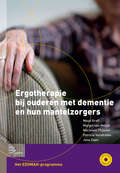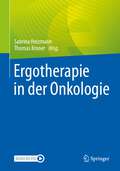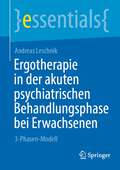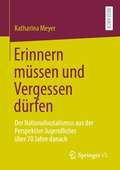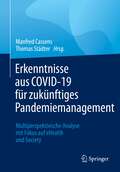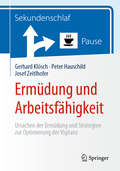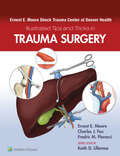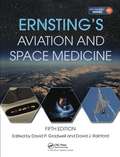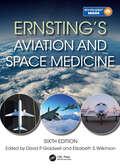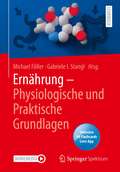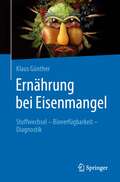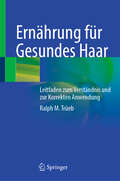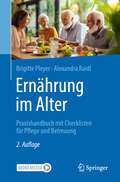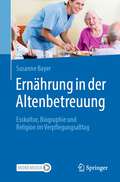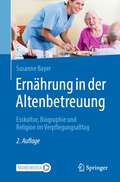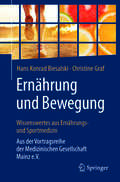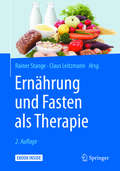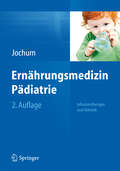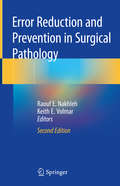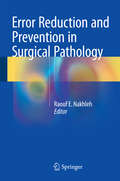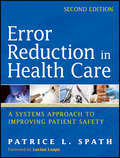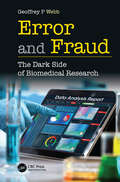- Table View
- List View
Ergotherapie bij ouderen met dementie en hun mantelzorgers: Het EDOMAH-programma
by Maud Graff Margot Melick Marjolein Thijssen Patricia Verstraten Jana ZajecErgotherapie bij ouderen met dementie en hun mantelzorgers' bevat de beschrijving van en praktische werkmaterialen voor een nieuw evidence based ergotherapieprogramma voor diagnostiek en behandeling van ouderen met dementie en hun mantelzorgers aan huis: het EDOMAH-programma. In deze vorm van ergotherapie zijn alle elementen van succesvolle psychosociale interventies terug te vinden: gerichtheid op persoonlijke behoeften en mogelijkheden, en intensieve begeleiding. In deel 1 worden achtergronden gegeven van dit interventieprogramma. Deel 2 is een werkboek dat de praktische toepassing van dit programma beschrijft in concreet uitgewerkte stappen en handelingen voor de ergotherapeut. De bijlagen in deel 3 bevatten diverse praktische materialen die direct bruikbaar zijn bij de toepassing van het programma. De dvd-rom bevat filmfragmenten uit de praktijk en printbare interview- en observatie-instrumenten. Dit praktijkboek is bedoeld voor ergotherapeuten die thuiswonende ouderen met lichte en matige dementie en hun mantelzorgers behandelen.
Ergotherapie in der Onkologie
by Thomas Kroner Sabrina HeizmannDieses Praxisbuch liefert Ergotherapeuten die ideale Grundlage für die Arbeit in der Onkologie. Wie kann ich als Ergotherapeut meine Klienten mit Fatigue unterstützen? Welche Interventionen und Tipps helfen meinen Klienten bei chemotherapieinduzierter Polyneuropathie? Wie bewältige ich als Therapeut belastende Ereignisse im Beruf? Vom onkologischen Basiswissen wie Tumorbiologie und Diagnostik über die wichtigsten onkologischen Behandlungsmethoden bis hin zur Therapie im interdisziplinären Team: Dieses Buch hilft Ihnen, adäquat auf die spezielle Situation Ihrer onkologischen Klienten einzugehen.Aus dem Inhalt:• Tumorbiologie, Diagnostik, operative und medikamentöse Therapien• Spezialwissen, u.a. zu Fatigue, Schmerz und kognitiver Dysfunktion• Ergotherapeutische Befundaufnahme und Behandlung, Arbeiten im interdisziplinären Team• Die häufigsten Tumoren – Klinik und BehandlungEgal ob im ambulanten oder stationären Bereich: Unterstützen Sie Ihre Klienten dabei, mit ihrer Krebserkrankung den Weg zurück in den Alltag zu finden.Plus: Handouts, Checklisten und Dokumentationsvorlagen zum Download!
Ergotherapie in der akuten psychiatrischen Behandlungsphase bei Erwachsenen: 3-Phasen-Modell (essentials)
by Andreas LeschnikDie Ergotherapie in der akuten Krankheitsphase einer psychiatrischen Behandlung ist eine Herausforderung für den Patienten, da er sehr stark unter den Symptomen und der medikamentösen Einstellung leidet. Zudem kommt mit durchschnittlich 24,7 Tage im Krankenhaus eine kurze Verweilzeit hinzu. Welches ergotherapeutische Behandlungskonzept macht also Sinn? Dieses essential bietet mit seinem 3-Phasen-Modell ein Grundgerüst, wie man mit welchen Modellen Patientendaten erheben, Interventionen setzen und Evaluationen durchführen kann und zwar nach jeder Therapieeinheit, um festzustellen, welche Fortschritte der Patient macht und ob die Therapie neu angepasst werden muss.
Erinnern müssen und Vergessen dürfen: Der Nationalsozialismus aus der Perspektive Jugendlicher über 70 Jahre danach
by Katharina MeyerMehr als 70 Jahre nach dem Ende des Nationalsozialismus prägt die wachsende zeitliche Distanz zum historischen Geschehen die Auseinandersetzung mit diesem. Veränderte familiäre Bezüge, der Abschied von Zeitzeug*innen und gegenwärtige gesellschaftliche Diskurse nehmen Einfluss auf die Perspektiven Jugendlicher. Dies wirft eine Vielzahl von Fragen auf: Wie beschäftigen sich junge Menschen in Deutschland mehr als sieben Jahrzehnte nach dem Holocaust mit dem Thema? Welche Relevanz hat der Nationalsozialismus für sie, welche geschichtlichen Vorstellungen von der Zeit haben sie und wie erleben sie den Umgang damit in Deutschland? Die Studie geht diesen Fragen anhand des Gruppendiskussionsverfahrens und der Grounded Theory Methodologie empirisch nach, nimmt Kontinuitäten und Brüche in den Bezügen zum Nationalsozialismus in den Blick und zeigt Zusammenhänge zur Identifikation mit Deutschland auf.
Erkenntnisse aus COVID-19 für zukünftiges Pandemiemangement: Multiperspektivische Analyse mit Fokus auf eHealth und Society
by Manfred Cassens Thomas StädterDieses Herausgeberwerk vereint die Vorträge und zusammengefassten Diskussionen der 7. Transfertagung "eHealth & Society 2022" zum Thema: "Erkenntnisse aus COVID-19 - Was bedeuten diese für zukünftiges Pandemiemanagement?". Die Beiträge diskutieren zahlreiche Perspektivfragen, so vor allem diejenige nach den Erkenntnissen für zukünftiges Epidemiemanagement mit Unterstützung von eHealth und digitalen Lösungen wie elektronische Patientenakte und telemedizinische Angebote. Der zweite Fokus der Beiträge liegt auf der Analyse gesellschaftlicher und sozialer Konsequenzen aus der Pandemiesituation und beschäftigt sich mit Fragen der Partizipation, Gesundheitskommunikation, Gesundheitskompetenz und Gesundheitsbildung. Dabei wird ersichtlich, dass sich an den Schnittstellen von medizinischer Versorgung, Bildung und Staat ein erheblicher Innovationsbedarf mit entsprechenden perspektivisch absehbaren Veränderungspotenzialen abzeichnet und in naher Zukunft mit gut durchdachten und eHealth-gestützten Konzepten dringlichst gedeckt werden sollte. Erste Anregungen und praxisrelevante Hinweise werden in den Beiträgen mitgeliefert.
Ermüdung und Arbeitsfähigkeit: Ursachen der Ermüdung und Strategien zur Optimierung der Vigilanz
by Gerhard Klösch Peter Hauschild Josef ZeitlhoferDieses Buch über Wachheit / Vigilanz richtet sich an Ärzte, Psychologen, Gesundheitsmanager und Sicherheitsfachkräfte und versteht sich als Einführung in das Gebiet der Vigilanzforschung. Aktiv, fit und leistungsfähig zu sein sind Attribute, die hoch im Kurs stehen. Die Schattenseite: Erschöpfung, Müdigkeit und Ausgebranntsein nehmen rasant zu. Einer der Gründe: chronischer Schlafmangel. Doch Müdigkeit hat viele Facetten und Ursachen. Dieses Buch, von Experten auf dem Gebiet der Schlafmedizin und Chronobiologie geschrieben, zeigt die physiologischen und psychologischen Hintergründe von Ermüdungsprozessen und informiert, wie Vigilanz und Müdigkeit gemessen werden können, welche Strategien helfen, um wach zu bleiben, und wie Übermüdungssituationen am Arbeitsplatz evaluiert werden können. Aus dem Inhalt: Vigilanz, Müdigkeit, Schläfrigkeit, Fatigue: Versuch einer Begriffsbestimmung – Das Konstrukt Vigilanz - Anatomie und Physiologie der Wachheit – Der feine Unterschied: Belastung oder Beanspruchung – Messverfahren zu Vigilanz und Ermüdung – Strategien zur Optimierung der Vigilanz – Fatigue Risk Management - Vermeidung und Prävention müdigkeitsbedingter Unfälle. Die Autoren: Gerhard Klösch, MPH ist Schlafforscher und stellvertretender wissenschaftlicher Leiter des Zertifikatskurses Schlafcoaching an der Medizinischen Universität, Wien. Dr. Peter Hauschild und Prof. Josef Zeitlhofer leiten das Institut für Chronopsychologie und Chronomedizin an der Sigmund Freud PrivatUniversität, Wien.
Ernest E. Moore Shock Trauma Center at Denver Health Illustrated Tips and Tricks in Trauma Surgery
by Ernest E. Moore Charles Fox Fredric M. PieracciOriginating from the Ernest E. Moore Shock Trauma Center at Denver Health, this new volume in the Illustrated Tips and Tricks series, Ernest E. Moore Shock Trauma Center at Denver Health Illustrated Tips and Tricks in Trauma Surgery, provides succinct, precise information from Dr. Ernest E. Moore, Charles J. Fox, Fredric M. Pieracci, and a wide range of experts on tackling technical problems in trauma surgery. Practical, hands-on content conveys knowledge gained from years of surgical experience, including nuggets of wisdom unique to this particular institution. Illustrations and operative photos are used liberally throughout the book to demonstrate surgical techniques and provide a handy visual complement to the text.
Ernstige psychiatrische aandoeningen
by Ad Kaasenbrood Lex WunderinkAls mensen langere tijd (meerdere jaren) lijden aan een psychiatrische stoornis en daardoor ook in de problemen komen met bijvoorbeeld hun relaties, werk, financiën of woonplek, dan kun je spreken van een ernstige psychiatrische aandoening (EPA). Niet zelden zijn tegelijkertijd verschillende stoornissen aanwezig waardoor de aandoening én de behandeling ervan complex is. Mensen met een ernstige psychiatrische aandoening kunnen met verschillende soorten stoornissen kampen.Naar schatting hebben ruim 280.000 mensen in Nederland (1,7% van de totale bevolking) een ernstige psychische aandoening. Deze groep is door de aard van de problematiek lastig te behandelen. Doel van dit boek is om handvatten aan behandelaren te geven in de omgang met EPA-patiënten, richting te geven voor de behandeling en te inspireren.
Ernsting's Aviation And Space Medicine
by David DavidErnsting's Aviation and Space Medicine applies current understanding in medicine, physiology and the behavioural sciences to the medical challenges and stresses that are faced by both civil and military aircrew, and their passengers, on a daily basis. <p><p> The fifth edition of this established textbook has been revised and updated by a multi-disciplinary team of experienced contributors, and includes new chapters on space physiology and medicine, passenger safety, rotary wing operation by land and sea, and UAVs. It remains the recommended textbook for those studying for the Diploma in Aviation Medicine of the Faculty of Occupational Medicine of the Royal College of Physicians, recognized worldwide as a standard in the field, and for similar overseas qualifications. <p> Ernsting's Aviation and Space Medicine remains an essential companion for all civil and military aviation medicine practitioners, both when preparing for professional examinations and in daily practice, and for those in the many disciplines of the behavioural and life sciences that include some study of aviation, its physiology and related issues. It is also recommended reading for those with a wider interest in the medical problems of professional or recreational flying, air transport and the aviation industry.
Ernsting's Aviation and Space Medicine
by David P. Gradwell Elizabeth S. WilkinsonErnsting's Aviation and Space Medicine applies current understanding in medicine, physiology and the behavioural sciences to the medical challenges and stresses that are faced by both civil and military aircrew, and their passengers, on a daily basis. The sixth edition of this established textbook and clinical reference has been revised and updated by a multidisciplinary team of experienced contributors, many new to this edition. The structure of the book has been refined, bringing related chapters together where appropriate, while the clinical content has been carefully streamlined in line with the specific requirements of the aviation medicine practitioner and adviser, with new chapters added on Commercial Space Travel, Skin Disease and Women’s Health.Key Features: Convenient – embraces all aspects of aviation medicine in a single volume, divided into four parts for ease of reference: Aviation Physiology & Aircrew Systems, Space Physiology & Medicine, Clinical Aviation Medicine and Operational Aviation Medicine Comprehensive – covers all forms of military and passenger-carrying aircraft, including issues surrounding passenger safety and transport of the sick and injured Aids detailed understanding – focuses on the principles underlying the standards in the field rather than just the standards themselves Applicable worldwide – addresses international issues, including worldwide regulation of medical standards, and travel and disease Accessible – chapter summaries enable rapid assimilation of key points while key references and suggestions for further reading encourage in-depth learning eBook included - text fully online and searchable via VitalSource eBook The text remains the recommended coursebook for those studying for the Diploma in Aviation Medicine of the Faculty of Occupational Medicine of the Royal College of Physicians, recognized worldwide as an exemplary standard in the field, and for similar worldwide qualifications. It is an essential companion for all civil and military aviation medicine practitioners, both when preparing for professional examinations and in daily practice, and for those in the many disciplines of the behavioural and life sciences that include some study of aviation, its physiology and related issues. It is also recommended reading for those with a wider interest in the medical problems of professional or recreational flying, air transport and the aviation industry.
Ernährung - Physiologische und Praktische Grundlagen
by Wim WätjenWas geschieht mit den verzehrten Lebensmitteln im Körper? Welche Nährstoffe brauchen wir in welchem Lebensalter, und kann Nahrung auch schädlich sein? Das Lehrbuch gibt einen umfassenden Überblick über die ernährungsphysiologischen Grundlagen, die zum erfolgreichen Bestehen eines ernährungswissenschaftlichen Studiums erforderlich sind. Kurze einführende Beispiele eröffnen die Kapitel und werfen so wichtige Fragen auf, die im weiteren Verlauf aufgegriffen werden. Zahlreiche Abbildungen und Kurzzusammenfassungen erleichtern das Lernen und die Prüfungsvorbereitung. Das Lehrbuch beschreibt auf anschauliche Weise, wie Nährstoffe aufgenommen werden, welche Funktionen sie im Körper haben und welcher Regulation sie unterliegen. Weitere Kapitel befassen sich mit den verschiedenen Methoden der Ernährungserhebung und den besonderen Nährstoffbedürfnissen von Menschen im Laufe ihres Lebenszyklus sowie mit der Ernährungstoxikologie. Das Lehrbuch greift in einzigartiger Weise auch die vorgeburtliche Ernährung auf und behandelt, wie wir Nahrungsmittel schmecken und riechen, wie die Gefühle von Hunger und Sättigung entstehen und welche Inhaltsstoffe von Lebensmitteln uns schaden.
Ernährung bei Eisenmangel: Stoffwechsel - Bioverfügbarkeit - Diagnostik
by Klaus GüntherRund ein Viertel der Weltbevölkerung ist von Eisenmangel betroffen, als besondere Risikogruppe gelten Frauen im gebärfähigen Alter sowie Kinder und Jugendliche. Das Fachbuch beschäftigt sich mit den neuesten wissenschaftlichen Erkenntnissen rund um die Eisenversorgung des menschlichen Organismus mit natürlichen Lebensmittel. Dabei räumt es mit dem Irrglauben auf, dass pflanzliches Eisen weniger wertvoll ist als tierisches Eisen, indem es die Eisenaufnahme aus pflanzlichen Lebensmitteln über einen neu entdeckten Stoffwechselweg vorstellt. Daraus lassen sich neue Gesichtspunkte für Vegetarier und Veganer ableiten, die bislang zur Risikogruppe zählten. Des Weiteren widmet es sich den vielfältigen Diagnosemöglichkeiten eines Eisenmangels und beschreibt gängige Methoden zur Bestimmung der Bioverfügbarkeit von Eisen in Lebensmitteln. Neue Erkenntnisse über die Biochemie des Eisens im Hirnstoffwechsel, die Wechselwirkung von Eisen mit anderen Spurenelementen sowie praktische Hinweise für besondere Ernährungsweisen, Risikogruppen und Altersklassen und Kochrezepte mit einfachen Angaben zur Eisenaufnahme komplettieren das Werk. Das Buch richtet sich an Ernährungs- und Allgemeinmediziner, Ernährungs- und Lebensmittelwissenschafter, Diätologen, Apotheker und Ernährungsberater.
Ernährung für Gesundes Haar: Leitfaden zum Verständnis und zur korrekten Praxis
by Ralph M. TrüebDie Quantität und Qualität des Haares stehen in engem Zusammenhang mit dem Ernährungszustand eines Menschen. Und doch gibt es kaum einen anderen Bereich, der mit so vielen Vorurteilen, falschen Vorstellungen und Diskussionen behaftet ist wie Ernährung und Gesundheit, ganz zu schweigen von der Haargesundheit. Die Gänge der Apotheken und Internet-Drogerien sind voll von Nahrungsergänzungsmitteln, die volles, dickes, üppiges Haar zu Preisen versprechen, die von verdächtig billig bis entmutigend überhöht reichen. Da ein erhebliches kommerzielles Interesse am Nährwert verschiedener Nahrungsergänzungsmittel besteht, stellt sich die zentrale Frage, ob eine Erhöhung des Nährstoffgehalts einer bereits ausreichenden Ernährung das Haarwachstum und die Haarqualität weiter fördern kann. Ziel dieses Buches ist es, Fakten von Fiktion zu unterscheiden und eine solide wissenschaftliche Grundlage für ernährungsbasierte Strategien für gesundes Haar zu schaffen, wobei gleichzeitig die Probleme und Grenzen unseres derzeitigen Verständnisses und unserer Praxis anerkannt werden.
Ernährung im Alter: Praxishandbuch mit Checklisten für Pflege und Betreuung
by Brigitte Pleyer Alexandra RaidlDas Buch befasst sich mit der veränderten Ernährungssituation im fortgeschrittenen Alter. Praxisnah werden Wege aufgezeigt, die hin zu einer gesunden, abwechslungsreichen und bedarfsgerechten Ernährung ohne viel Aufwand führen und im Pflegealltag integrierbar sind. Nach der übersichtlichen Darstellung der physiologischen und psychologischen Veränderungen werden hilfreiche Maßnahmen für den Alltag aus der Trias Ernährung, Bewegung und Psyche behandelt. Beispiele und zahlreiche Checklisten sind dabei für das Dokumentieren von Verbesserungen nützlich. Essen erfüllt auch soziale Aspekte, wie das gemeinsame Essen und die Bedeutung der Mahlzeit als Struktur für den Tagesablauf. Es wird auch auf Folgen von Isolation wie zu Zeiten der Pandemie (COVID 19) eingegangen.Im umfangreichen Praxisteil sind Auswahl, Einkauf, Portionsgrößen und Zubereitung ebenso, wie die Küchenausstattung und das altersadaptierte Anrichten von Speisen behandelt. Zudem werden im Rezeptteil einfacheBasisgerichte und Kombinationsbeispiele für den Essalltag angeboten. Nützliche Kontaktadressen runden die Inhalte ab. Neu sind Informationen zu den kostenlosen iMooX-Selbstlernkursen: Essgenuss im Alter sowie Demenz und Ernährung.Das Buch richtet sich an stationäre und ambulante Pflegepersonen, Altenbetreuung, Heimhilfe, Ernährungsexperten und andere Gesundheitsberufe sowie Betroffene und Angehörige. Durch den didaktischen Aufbau ist es auch als Lehrbuch für die Aus- und Fortbildung geeignet.
Ernährung in der Altenbetreuung: Esskultur, Biographie und Religion im Verpflegungsalltag
by Susanne BayerSo verschieden die individuellen Ernährungsvorlieben und Gebräuche sind, so unterschiedlich sind die Bedürfnisse älterer, betreuungsbedürftiger Menschen. Das Buch fasst die Empfehlungen für bedarfs- und bedürfnisgerechte Ernährung in der Geriatrie leicht verständlich zusammen und geht darüber hinaus auf spezielle Bedürfnisse aus der Biografie und der Religion der zu betreuenden älteren Menschen ein. In Bezug auf die Lebensqualität nimmt das Essen in der Altenbetreuung immer einen zentralen Stellenwert ein.Gemeinsamkeiten und Unterschiede von Ernährungsgewohnheiten in verschiedenen Religionen und praxisbezogene Hilfestellungen für den Verpflegungsalltag komplettieren das Buch. Mit den vielen Ratschlägen können Konflikte vermieden und die Essenssituation kann für alle Seiten angenehm gestaltet werden. Ein wichtiger Teil sind die Geschichten und Rezepte der hochaltrigen Menschen, sie helfen ein Verständnis für die individuellen Bedürfnisse zu entwickeln. Zum leichteren Nachkochen unterstützen die Videos.Das Buch richtet sich an Betreuende und Pflegende älterer Menschen, aber auch soziale Dienstleister und Ausbildungseinrichtungen werden darin Impulse für ihre Arbeit erhalten.
Ernährung in der Altenbetreuung: Esskultur, Biographie und Religion im Verpflegungsalltag
by Susanne BayerSo verschieden die individuellen Ernährungsvorlieben und Gebräuche sind, so unterschiedlich sind die Bedürfnisse älterer, betreuungsbedürftiger Menschen. Das Buch fasst die Empfehlungen für bedarfs- und bedürfnisgerechte Ernährung in der Geriatrie leicht verständlich zusammen und geht darüber hinaus auf spezielle Bedürfnisse aus der Biografie und der Religion der zu betreuenden älteren Menschen ein. In Bezug auf die Lebensqualität nimmt das Essen in der Altenbetreuung immer einen zentralen Stellenwert ein.Gemeinsamkeiten und Unterschiede von Ernährungsgewohnheiten in verschiedenen Religionen und praxisbezogene Hilfestellungen für den Verpflegungsalltag komplettieren das Buch. Mit den vielen Ratschlägen können Konflikte vermieden und die Essenssituation kann für alle Seiten angenehm gestaltet werden. Ein wichtiger Teil sind die Geschichten und Rezepte der hochaltrigen Menschen, sie helfen ein Verständnis für die individuellen Bedürfnisse zu entwickeln. Zum leichteren Nachkochen unterstützen die Videos.Das Buch richtet sich an Betreuende und Pflegende älterer Menschen, aber auch soziale Dienstleister und Ausbildungseinrichtungen werden darin Impulse für ihre Arbeit erhalten.
Ernährung und Bewegung - Wissenswertes aus Ernährungs- und Sportmedizin: Aus der Vortragsreihe der Medizinischen Gesellschaft Mainz e.V.
by Hans Konrad Biesalski Christine GrafIm vorliegenden Buch wird die Bedeutung von Ernährung und Bewegung für die Gesundheit dargestellt. Der interessierte Leser erhält Empfehlungen auf Grundlage aktueller wissenschaftlicher und klinischer Erkenntnisse.Wie beeinflussen Ernährungstrends oder Diäten die Gesundheit?Was begünstigt die Entstehung von Erkrankungen?Welche Sportarten und wie viel Bewegung sind empfehlenswert?Die erfahrenen Ernährungs- und Sportmediziner zeigen, dass jeder mit einem Lebensstil aus gesunder Ernährung und sportlicher Betätigung zu seiner Gesundheit und Lebensqualität wesentlich beitragen kann.
Ernährung und Fasten als Therapie
by Rainer Stange Claus LeitzmannDie 2. Auflage dieses Buch, inkl. ebook, aus der Naturheilkunde wurde von den renommierten Herausgebern und Autoren komplett aktualisiert, beschreibt den aktuellen Stand moderner Ernährungsformen und Fastenmethoden und wie diese gezielt präventiv und therapeutisch einsetzbar sind. Neue Themen wurden aufgenommen wie folgt: „Ernährungssituation in Deutschland“, „Neueste Ergebnisse zu Fasten“, „Krebs“ und „Nährstoffsupplemente“. In diesem Buch finden Ärzte, Ernährungswissenschaftler, Diätassistenten und Heilpraktiker bewährte Ernährungskonzepte, die Indikation bei bestimmten Erkrankungen und die aktuelle Studienlage dazu. Der Inhalt Grundlagen zu Ernährung und FastenAusgewählte NahrungsinhaltsstoffeGrundlegende Formen der ErnährungstherapieFasten als Erlebnis, Prävention und TherapiePlus: Empfehlenswerte Ernährung bei Nahrungsmittelunverträglichkeiten und bestimmten Krankheitsbildern Aktuelle Forschungsmethoden und Trends rund um die Ernährung: Mit diesem Nachschlagewerk können Sie Ihre Patienten optimal beraten und behandeln.
Ernährungsmedizin Pädiatrie
by Frank JochumDie Basis für eine gesunde Entwicklung von Kindern und Jugendlichen ist die bedarfsgerechte Zufuhr von Nährstoffen. Da eine systematische Lehre auf diesem Gebiet fehlt, bestehen häufig Wissensdefizite. Orientiert am Zertifikat Ernährungsmedizin der Deutschen Gesellschaft für Kinder- und Jugendmedizin, wurden für den Leitfaden die Grundlagen zusammengefasst und das therapeutische Vorgehen beschrieben. Die 2. Auflage bietet einen Praxisteil mit Übersichten und Berechnungshilfen zur klinischen Ernährung sowie Empfehlungen für die Nährstoffzufuhr.
Ernährungsmedizin und Diätetik: Unter Mitarbeit von Walter Burghardt, German Edition
by Heinrich KasperWenn Essen krank macht – das Standardwerk rund um ernährungsbedingte Krankheiten <P><P>„Du bist, was Du isst …" – Ernährungsfaktoren beeinflussen entscheidend die Entstehung verschiedener Erkrankungen, wie Diabetes mellitus Typ 2, Arteriosklerose oder Bluthochdruck. Ernährungsbedingte Erkrankungen nehmen in den letzten Jahrzehnten kontinuierlich zu. Fundierte Kenntnisse der Ernährungsmedizin sind daher besonders wichtig, um diese Krankheiten mit der richtigen Diätetik therapieren oder sogar verhindern zu können. Medizinstudenten, Ärzte, Diätassistenten und Ökotrophologen finden in dem bewährten Standardwerk „Ernährungsmedizin und Diätetik" genau diese Informationen zum Lernen und Nachschlagen. <P><P>Die neue, 12. Auflage wurde inhaltlich komplett aktualisiert – alle Literaturangaben sind wieder in der gedruckten Ausgabe verfügbar. <P><P>Das erwartete Sie in „Ernährungsmedizin und Diätetik": <P><P> <ul> <li>Gut verdaulich durch exzellente Didaktik</li> <li>Reich an klinischen Bezügen, praktischen Hinweisen und Anregungen für die Praxis</li> <li>Auf dem neuesten Erkenntnisstand</li> </ul>
Eros and Illness
by David B. MorrisWhen we or our loved ones fall ill, our world is thrown into disarray, our routines are interrupted, our beliefs shaken. David Morris offers an unconventional, deeply human exploration of what it means to live with, and live through, disease. He shows how desire—emotions, dreams, stories, romance, even eroticism—plays a crucial part in illness.
Error Reduction and Prevention in Surgical Pathology
by Raouf E. Nakhleh Keith E. VolmarThe 1st edition of Error Reduction and Prevention in Surgical Pathology was an opportunity to pull together into one place all the ideas related to errors in surgical pathology and to organize a discipline in error reduction. This 2nd edition is an opportunity to refine this information, to reorganize the book to improve its usability and practicality, and to include topics that were not previously addressed. This book serves as a guide to pathologists to successfully avoid errors and deliver the best diagnosis possible with all relevant information needed to manage patients. The introductory section includes general principles and ideas that are necessary to understand the context of error reduction. In addition to general principles of error reduction and legal and regulatory responsibilities, a chapter on regulatory affairs and payment systems which increasingly may be impacted by error reduction and improvement activities was added. This later chapter is particularly important in view of the implementation of various value-based payment programs, such as the Medicare Merit-Based Incentive Payment System that became law in 2015. The remainder of the book is organized in a similar manor to the 1st edition with chapters devoted to all aspects of the test cycle, including pre-analytic, analytic and post-analytic. The 2nd Edition of Error Reduction and Prevention in Surgical Pathology serves as an essential guide to a successfully managed laboratory and contains all relevant information needed to manage specimens and deliver the best diagnosis.
Error Reduction and Prevention in Surgical Pathology
by Raouf E. NakhlehTissue diagnosis in surgical pathology is the most important determinant of patient outcomes in oncology and other medical conditions. An appropriate diagnosis of a tumor correctly determines the necessary therapy for that patient. Error Reduction and Prevention in Surgical Pathology focuses on how errors happen, the best systems to detect errors and the best systems to prevent errors. As with any form of testing, the test cycle in surgical pathology can be divided into pre-analytic (collection and handling of specimens), analytic (the actual determination of disease or other diagnostic information) and post-analytic (generation of reports and distribution). Error can occur anywhere in the process and all of these steps must be performed optimally so that the correct diagnosis is made and delivered. Error Reduction and Prevention in Surgical Pathology serves as an essential guide to a successfully managed laboratory and contains all relevant information needed to manage patients and deliver the best diagnosis.
Error Reduction in Health Care
by Patrice L. SpathError Reduction in Health CareCompletely revised and updated, this second edition of Error Reduction in Health Care offers a step-by-step guide for implementing the recommendations of the Institute of Medicine to reduce the frequency of errors in health care services and to mitigate the impact of errors when they do occur. With contributions from noted leaders in health safety, Error Reduction in Health Care provides information on analyzing accidents and shows how systematic methods can be used to understand hazards before accidents occur. In the chapters, authors explore how to prioritize risks to accurately focus efforts in a systems redesign, including performance measures and human factors. This expanded edition covers contemporary material on innovative patient safety topics such as applying Lean principles to reduce mistakes, opportunity analysis, deductive adverse event investigation, improving safety through collaboration with patients and families, using technology for patient safety improvements, medication safety, and high reliability organizations. The Editor
Error and Fraud: The Dark Side of Biomedical Research
by Geoffrey P. WebbThis fascinating book gives readers an appreciation of how biomedical research should work and how the reality is all too often seriously flawed. Explaining the logical basis of the different research approaches used by biomedical research scientists and their relative merits, it will help readers to make more realistic appraisal of media reports linking aspects of lifestyle, environment or diet to health outcomes and thus judge whether such claims are a real effect worthy of consideration for behavior change or deserving of further research resources. Key features: increases awareness of research fraud and some of the characteristics of fraudulent science and scientific fraudsters shows that whilst outright fraud may be uncommon, fudging of results to help achieve statistical significance may be more prevalent incorporates real-life case studies highlighting some of the infamous cases of research fraud and major scientific mistakes and the impact that they have had provides a convenient overview of the research process in the biomedical sciences, with a focus on research strategy rather than individual methods find supplemental detail on the author’s blog https://drgeoffnutrition.wordpress.com/about/ By raising awareness of the possibility that research data may have been dishonestly generated and outlining some of the signs and symptoms that might suggest data fabrication, Error and Fraud: The Dark Side of Biomedical Research will help students and researchers to identify the strengths and limitations of different research approaches and allow them to make a realistic evaluations of their own and others’ research findings.
